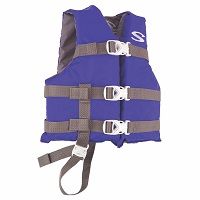Do you enjoy spending a day out on the water with your family? Do you live near a body of water such as an ocean, lake, or swimming pool? If this is the case and you own children, you need to have an infant life vest. Many new parents believe that when they have a young child that they must stay away from the water or off of the boat. That isn't necessary, but if you do choose to enjoy the water with your infant, do you know if you have the correct infant life vest?
Have you ever taken your eye off of your child for even 30 seconds? Let's face it; no parent can watch their child's every move. The correct type and properly fitting infant life vest can save your child's life if they happen to fall into the water, but not all of them are created equal. Why not just put them in an adult life vest you already have lying around or just put inflatable arm bands around them? What about those noodles, they are fine right? These might seem like good ideas, but they may be putting your child or infant in just as much danger as not wearing an infant life vest at all.
So, you now agree that you should have a life vest for your infant, toddler, or young child. Are all created equal? What are with those Type I, II, III, and IV safety ratings? When will the infant life vest be too small or big? Infant life vests are typically for children 15 - 30 lbs, while toddler life vests are for children 30 - 50 lbs, and youth life vests for children 50 - 90 lbs. It is recommended that infants and toddlers wear a Type II vest, while youths use a Type III or Type II life vest.
What if you toddler or infant doesn't want to wear that boring old orange life vest? There are now many great colors and styles of infant life vests to choose from, and some even have your child's favorite characters on them. If you give your child a choice in the purchase of their infant life vest, they are very likely to want to wear the vest each time they are out on the water.
If you are out on the water this summer with your family, make sure they are all protected. Make sure you are a well informed consumer and you know what each safety type means and what materials and styles are out there. Remember, the best infant life vest is one that your child will wear!

